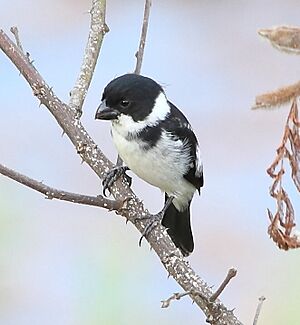Wing-barred seedeater facts for kids
Quick facts for kids Wing-barred seedeater |
|
|---|---|
 |
|
| A male wing-barred seedeater in Brazil | |
| Conservation status | |
| Scientific classification | |
| Genus: |
Sporophila
|
| Species: |
americana
|
 |
|
The wing-barred seedeater (Sporophila americana) is a small songbird found in parts of South America. It lives along the coasts of north-eastern Venezuela, Tobago, and the Guianas. You can also find it in parts of Brazil, especially near the Amazon River.
This bird used to be grouped with other similar birds, but now scientists consider it a separate species.
Contents
What Does the Wing-barred Seedeater Look Like?
This bird is about 11 centimeters (4.3 inches) long. That's roughly the size of a small sparrow!
Male wing-barred seedeaters are easy to spot. They have a strong black beak. Their top feathers are black, but their lower back (rump) is greyish. They also have two clear white stripes on their wings. These are called "wing-bars." Their belly is white, with a wide black band across their chest. They might also have some black spots on their sides.
Female wing-barred seedeaters look different. They are much duller in color. They have a brownish beak. Their top feathers are dull olive-brown, and their belly is a pale olive-yellow. Young birds look a lot like the adult females.
Where Do Wing-barred Seedeaters Live?
Wing-barred seedeaters like to live in open areas. You can find them in grassy fields or places with small bushes. They usually live in pairs or small groups.
What Do Wing-barred Seedeaters Eat?
Like other seedeaters, these birds mostly eat seeds. But they also enjoy eating flowers, buds, and fruits. They are always looking for tasty snacks in their habitat!
Is the Wing-barred Seedeater Safe?
This bird is still quite common in places like Suriname, French Guiana, and parts of Brazil. Because of this, experts believe it is a species of "least concern." This means it is not currently in danger of disappearing.
However, in Venezuela and Guyana, it is less common. Here, people sometimes try to catch these birds to sell them as pets. This can be a threat to their numbers in those areas.


